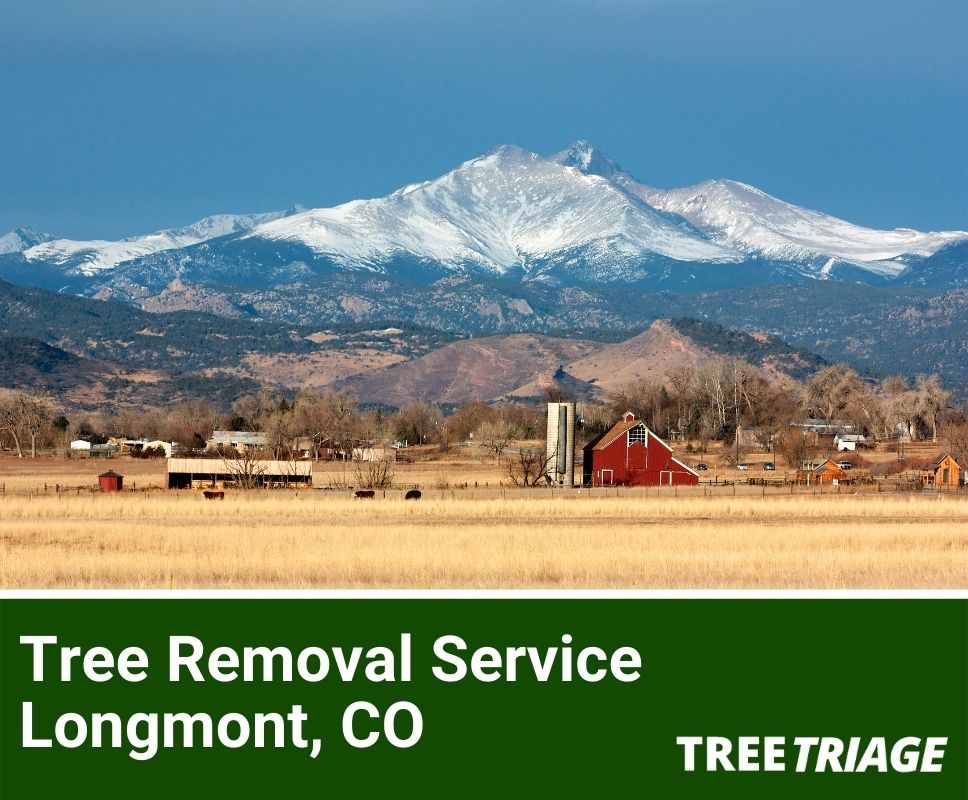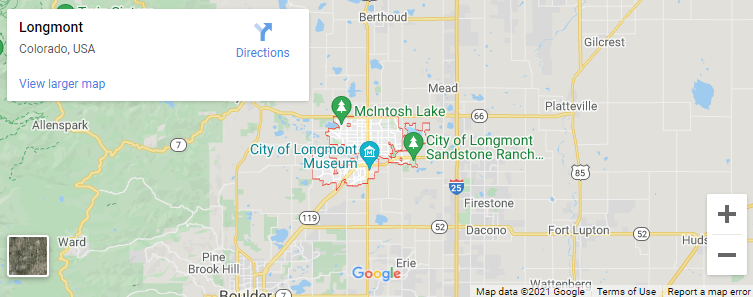Contents (Click To Jump)
- 1 What Are the Most Common Tree Issues in Longmont?
- 2 Does the City of Longmont Provide Any Assistance in Tree Removal Problems?
- 3 Who Is Responsible For Fallen Tree Removal in Longmont?
- 4 How Does the Soil Affect Trees in Longmont?
- 5 Does Weather Affect Tree Health in Longmont?
- 6 What If Dead Trees Are Near Power Lines in Longmont?
- 7 How Much Does Tree Removal Usually Cost in Longmont?
What Are the Most Common Tree Issues in Longmont?
The Emerald Ash Borer is a common problem in Longmont and throughout much of Colorado. This highly destructive beetle, which is native to Asia and has been spreading across the United States since 2002, attacks all sixteen species of ash trees. These insects bore holes that look similar to woodpecker holes in the bark of ash trees, which they use to enter the trees and eat their bark from the inside. This process weakens the ash trees by keeping them from getting enough water and nutrients, which typically kills them within a few years. Other signs that the Emerald Ash Borer may be present include foliage that turns yellow, becomes thinner, or wilts, which are typically early results of a lack of food and water. Although there are some options available for treating trees that experience an Emerald Ash Borer infestation, they tend to be ineffective, and even treated trees often die or need to be removed.
At this time, the City of Longmont is preemptively removing ash trees that are at a higher risk for an Emerald Ash Borer infestation and replacing them with new trees of a different species. These guidelines include ash trees that are especially small in diameter, located close to power lines, or in poor health. Ash trees currently make up approximately 13 percent of Longmont’s urban forest, and the city is aiming to lower this number to 10 percent by replacing ash trees with species that are not affected by the Emerald Ash Borer to minimize infestations and increase the diversity of tree species within the city.
Other common pests in the Longmont area include the Asian Gypsy Moth, the European Gypsy Moth, and the Spotted Lanternfly. European Gypsy Moth and Asian Gypsy Moth caterpillars destroy hundreds of species of trees by eating their leaves and Spotted Gypsy Moths feed on fruit and woody trees throughout the region.
Although the Asian Longhorned Beetle has not yet reached Colorado, the state’s many national forests and dense hardwood trees make the area’s conditions ideal for experiencing significant damage should these beetles arrive. These pests spread easily by moving wood that is infested with the insects or their eggs, which means that it is important for residents of Longmont to prioritize using firewood that was sourced within Colorado and preferably within Boulder or Weld County.
Does the City of Longmont Provide Any Assistance in Tree Removal Problems?
The City of Longmont offers free branch removal for residents that live within the city limits each spring. Neighborhoods are divided into two one-week collection segments and residents who are interested in this service must make sure their branches are stacked by their curbs by the Monday morning of their assigned week. Branches need to be less than six feet long and six inches in diameter to qualify for free pickup. Branches, yard waste, and certain other items can be brought to the Waste Diversion Center during the rest of the year. Residents can drop items off here for free for noncommercial purposes, and fees apply to landscapers and other commercial purposes.
The city and residents of Longmont are extremely committed to preserving the health and quantity of trees that make up Longmont’s urban forest, which is known as Tree City USA. With this in mind, the city discourages voluntary tree removal and actively takes steps to recycle trees and branches that cannot be saved. The Waste Diversion Center uses this wood to make mulch, which is available to residents to use for free. The city also offers replacement trees to residents each spring to take the place of any trees that need to be removed unless a yard does not have space to add a tree, which helps to handle necessary removals without decreasing the overall number of trees in the area.
Who Is Responsible For Fallen Tree Removal in Longmont?
In Colorado, having a fallen tree removed is usually the responsibility of the owner of the property where it lands. However, this can change if the owner of a tree knew it was diseased, infested by insects, or otherwise damaged.
If you’re a homeowner?
If your tree or a neighbor’s tree falls in your yard during a storm, you will be responsible for having it removed. You will also need to file a claim with your insurance company to cover any damage to your home, vehicle, or other property. The only exception to this guideline is that a neighbor will be responsible if you can prove that he or she knew about a problem with the tree and neglected to take care of it. Although it is difficult to prove what a neighbor knew, you can report a problem with a neighbor’s tree to Longmont’s Code Enforcement if you see something that looks hazardous, and talking to your neighbor is not enough to solve the problem.
If you’re a renter?
Renters are not responsible for tree removal. However, they should let their landlord know about any possible problems with trees in their yard that they observe to prevent trees from falling as the result of negligence.
If you’re a landlord?
Landlords are responsible for having fallen trees removed from their properties. They usually do not need to have their trees removed from someone else’s property unless the problem was caused by negligence.
If you’re a neighbor?
If your tree falls into a neighbor’s yard, you will generally not be responsible for removal or paying for damage unless the problem was your fault. Failing to take care of a problem you knew about shifts responsibility to you, and your neighbor can report your tree to the City of Longmont if you refuse to fix a problem that has the potential to affect your neighbor.
How Does the Soil Affect Trees in Longmont?
The soil in the Longmont area tends to have poor drainage, which can leave tree roots saturated in too much water. Although many trees in the region adapt somewhat to this challenge, poor drainage often results in trees not getting enough oxygen and becoming more vulnerable to pathogens in the soil. These problems are especially common with the clay soils that are found throughout much of Longmont, Denver, and nearby areas.
Does Weather Affect Tree Health in Longmont?
Most trees in the Longmont area are able to effectively handle the area’s cold winters and frequent snow as long as they have time to properly acclimate to the changing seasons. Trees in Colorado and other cold regions generally spend the fall months storing the extra sugars and amino acids that will sustain them throughout the winter before going dormant during the coldest months that are not conducive to growth. However, Longmont has experienced rapid drops in temperature over a short period of time in recent years that have made this process impossible.
During the fall of 2014, temperatures in Longmont dropped from 81 degrees to 16 degrees over the course of just a few weeks, which quickly brought the city from summer to winter with a much shorter fall than usual. Without the time to gradually prepare for the winter, many trees experienced discolored needles, frozen leaves, and other types of lasting damage. The area also sees these drastic temperature drops overnight from time to time, which can cause immediate damage that trees and plants are unable to recover from, even if temperatures do not stay low as they did in 2014. In the fall of 2019 and the spring of 2020, temperatures dropped from 70-80 degrees to temperatures between 10 and 24 degrees the following day. Although the weather did not stay cold, many of last spring’s new buds were lost and did not reappear.
Because Colorado’s winters are so cold, many species are not recommended when selecting trees to grow in your yard or at your business in Longmont and other cities that are near the mountains. Among others, aspens, silver maples, willows, tamarisks, and white-barked birches tend not to do well in the Front Range area. That being said, the Front Range tends to experience infrequent storms because the mountains often block them from reaching Longmont, Boulder, Denver, and other cities next to the Rockies. The area is also not prone to tornadoes, hurricanes, earthquakes, or other natural disasters which makes it a relatively safe area for species of trees that are able to survive cold winters.
What If Dead Trees Are Near Power Lines in Longmont?
Longmont residents should contact Longmont Power & Communications to report branches that are interfering with power lines or dead trees that land on or near power lines. Although Longmont Power & Communications handles all issues with city-maintained trees near power lines, you will need to handle pruning or tree removal of trees that are entirely on your property yourself or hire a city-licensed contractor like Tree Triage to do so. However, Longmont Power & Communications will temporarily turn off your power for you so that you can maintain or remove the tree safely.
How Much Does Tree Removal Usually Cost in Longmont?
Tree removal in Longmont generally ranges from $523-$710, with an average cost of $616. This estimate covers labor costs, as well as cleanup and any specialized equipment that may be needed. Although most tree removal needs fall within this range, there are several factors that can influence the total cost of your tree removal service and bring the total well above $1,500.
Size of the Tree
Large trees are often more difficult to remove without causing damage to nearby trees or buildings than small trees, and they are more likely to require a crane or other extra equipment to manage safely. In most circumstances, the cost of tree removal will rise proportionately to the height and diameter of your tree.
Location of the Tree
Trees that are difficult to reach or are located near power lines may cost more to remove than trees that are easy to get to.
Timing of Tree Removal
Tree removal should be scheduled in advance whenever possible. Although we will provide emergency services to remove a tree that is about to fall on your house, these services will usually be much more expensive and should be reserved for after storms or other unpreventable situations instead of simply letting a diseased tree be until it can’t hold itself up any longer.






